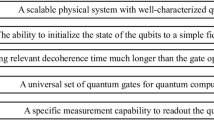Abstract
This paper presents a new split-radix algorithm for DHT of length \({N}=2^{n}\), called the Dual Split-Radix DHT (DSR DHT), that allows an efficient parallel implementation using a dual core system. Moreover, as it is different from existing split-radix algorithms for DHT, it offers an efficient hardware implementation similar to that for FFT. It avoids the so-called retrograde indexing specific to existing DHT algorithms that do not allow an efficient pipeline implementation.



Similar content being viewed by others
References
G. Bi, Y. Chen, Y. Zeng, Fast algorithms for generalized discrete Hartley transform of composite sequence length. IEEE Trans. Circuits Syst. II Analog Digit. Signal Process. 47(9), 893–901 (2000)
G. Bi, New split-radix algorithm for the discrete Hartley transform. IEEE Trans. Signal Process. 45(2), 297–302 (1997)
S. Bouguezel, M.O. Ahmad, M.N.S. Swamy, New parametric discrete Fourier and Hartley transforms, and algorithms for fast computation. IEEE Trans. Circuits Syst. I Regul. Papers 58(3), 562–575 (2011)
D.F. Chiper, Fast radix-2 algorithm for the discrete hartley transform of type II. IEEE Signal Process. Lett. 18(11), 687–689 (2011)
D.F. Chiper, Radix-2 fast algorithm for computing discrete Hartley transform of type III. IEEE Trans. Circuits Syst. II Express Briefs 59(5), 297–301 (2012)
D.F. Chiper, M.N.S. Swamy, M.O. Ahmad, An efficient systolic array algorithm for the VLSI implementation of prime-length DHT, in Proceedings of International Symposium on Signals, Circuits and Systems (ISSCS2005), vol. 1, pp. 167–169
D.F. Chiper, A novel VLSI DHT algorithm for a highly modular and parallel architecture. IEEE Trans. Circuits Syst. II 60(5), 282–286 (2013)
R.E. Crochiere, L.R. Rabiner, Multirate Digital Signal Processing (Prentice-Hall, Englewood Cliffs, 1983)
A.C. Erickson, B.S. Fagin, Calculating the FHT in hardware. IEEE Trans. Signal Process. 40(6), 1341–1353 (1992)
M.T. Heideman, Multiplicative Complexity, Convolution and the DFT (Springer, Berlin, 1988)
H.S. Hou, The fast Hartley transform algorithm. IEEE Trans. Comput. 147–156 (1987)
J. Hu, J. Deng, J. Wu, Image compression based on improved FFT algorithm. J. Netw. 6(7), 1041–1048 (2011)
T. Le-Ngoc, T.V. Minh, Implementation and performance of the fast Hartley transform. IEEE Micro 9(5), 20–27 (1989)
M. Marchesi, G. Orlandi, F. Piazza, A systolic circuit for fast Hartley transform, in IEEE International Symposium on, Circuits and Systems (1988)
P.K. Meher, J.C. Patra, M.N.S. Swamy, High throughput memory based architecture for DHT using a new convolutional formulation. IEEE Trans. Circuits Syst. II Express Briefs 54(7), 606–610 (2007)
P.K. Meher, T. Srikanthan, J.C. Patra, Scalable and modular memory-based systolic array architectures for discrete Hartley transform. IEEE Trans. Circuits Syst. I Regul. Pap. 53(5), 1065–1077 (2006)
R.C. de Oliveira, R.M. Campello de Souza, H.M. de Oliveira, Matrix expansions for computing the discrete Hartley transform for blocklength \(\text{N}\equiv 0\) (mod4), in IEEE Latin-America Conference on Communications, IEEE, LATINCOM, 7–9 Nov (2012)
M.A. O’Neill, Faster Than Fast Fourier, BYTE, (April 1988), pp. 293–300
S.B. Pan, R.H. Park, Unified systolic array for computation of DCT/DST/DHT. IEEE Trans. Circuits Syst. Video Technol. 7(2), 413–419 (1997)
A. Reeve, Optimized Fast Hartley Transform for the MC68000 with applications in image processing. Master Thesis, Thayer School of Engineering, Dartmouth College, Hanover, March 1990
H. Shu, Y. Wang, L. Senhadji, L. Luo, Direct computation of type-II discrete Hartley transform. IEEE Signal Process. Lett. 14(5), 329–332 (2007)
A.N. Skodras, M.F. Aburdene, A.K. Nandi, Two-band fast Hartley transform. Electron. Lett. 51(1), 57–59 (2015)
H.V. Sorensen, D.L. Jones, C.S. Burrus, M.T. Heideman, On computing the discrete Hartley transform. IEEE Trans. Acoust. Speech Signal Process. ASSP–33, 1231–1238 (1985)
Z. Wang, Harmonic analysis with a real frequency function, I Aperiodic case. Appl. Math. Comput. 9, 53–73 (1981)
Z. Wang, Harmonic analysis with a real frequency function, II. Periodic and bounded cases. Appl. Math. Comput. 9, 153–163 (1981)
Z. Wang, Harmonic analysis with a real frequency function, III Data sequence. Appl. Math. Comput. 9, 245–255 (1981)
D. Yang, Prime factor fast Hartley transform. Electron. Lett. 26(2), 119–121 (1990)
W.-C. Yeh, C.-W. Jen, High-speed and low-power split-radix FFT. IEEE Trans. Signal Process. 51(3), 864–874 (2003)
Author information
Authors and Affiliations
Corresponding author
Appendix
Appendix
1.1 Algorithms for Small DHTs
An efficient implementation of a fast DHT algorithm, with a simple and low complexity software or hardware structure, closely depends on efficient algorithms for a small DHTs. At the following link http://www.etti.tuiasi.ro/index.php?option=com_content&view=article&id=118:dfchiper&catid=37:cadre-didactice&Itemid=78, there are some efficient DHT algorithms for length \(N=4\) and \(N=8\) [7].
1.2 MATLAB Script for the Proposed Split-Radix DHT Algorithm


1.3 Solving the Recurrence Relations for the Arithmetic Complexity
(a) Solving \(M(N)=M(N/2)+2\cdot M(N/4)+7N/8-4\)
with \(M(4)=0\), \(M(8)=2\)
We can write
where
We note \(a_{00} (n)\), \(a_{01} (n)\) the elements \(a_{00}\) and \(a_{01}\) of \(A^{n}\).
We have
We can further write
where \(n=\log _2 N\).
Results
and finally
(b) Solving \(A(N)=A(N/2)+2A(N/4)+21N/8-4\)
with \(A(4)=8\); \(A(8)=16.\)
We can write
where
We note \(a_{00} (n)\), \(a_{01} (n)\) the elements \(a_{00}\) and \(a_{01} \) of \(A^{n}\).
We have
We can further write
where \(n=\log _2 N\).
and finally results
Rights and permissions
About this article
Cite this article
Chiper, D.F. A Structured Dual Split-Radix Algorithm for the Discrete Hartley Transform of Length \(2^{N}\) . Circuits Syst Signal Process 37, 290–304 (2018). https://doi.org/10.1007/s00034-017-0552-3
Received:
Revised:
Accepted:
Published:
Issue Date:
DOI: https://doi.org/10.1007/s00034-017-0552-3




